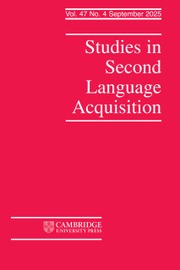Article contents
THE EVOLVING CONTEXT OF THE FUNDAMENTAL DIFFERENCE HYPOTHESIS
Published online by Cambridge University Press: 01 June 2009
Abstract
Foreign language learning contrasts with native language development in two key respects: It is unreliable and it is nonconvergent. At the same time, it is clear that foreign languages are languages. The fundamental difference hypothesis (FDH) was introduced as a way to account for the general characteristics of foreign language learning. The FDH was originally formulated in the context of the theory of rich Universal Grammar, and this theory has guided much foreign language acquisition research over the past two decades. However, advances in the understanding of language have undermined much of the supporting framework.
The FDH—indeed all of SLA research—must be rethought in light of these advances. It is proposed here that (a) foreign language grammars make central use of patches, which are also seen as peripheral phenomena in native languages; (b) non-domain-specific processes are used in foreign language acquisition, but that these are also employed—although more effectively because they are integrated into the language system—by native language development; and (c) foreign language online processing relies heavily on the use of shallow parses, but these are also available in native language processing, although less crucially.
- Type
- Research Articles
- Information
- Studies in Second Language Acquisition , Volume 31 , Special Issue 2: THE FUNDAMENTAL DIFFERENCE HYPOTHESIS TWENTY YEARS LATER , June 2009 , pp. 175 - 198
- Copyright
- Copyright © Cambridge University Press 2009
References
REFERENCES
- 147
- Cited by


